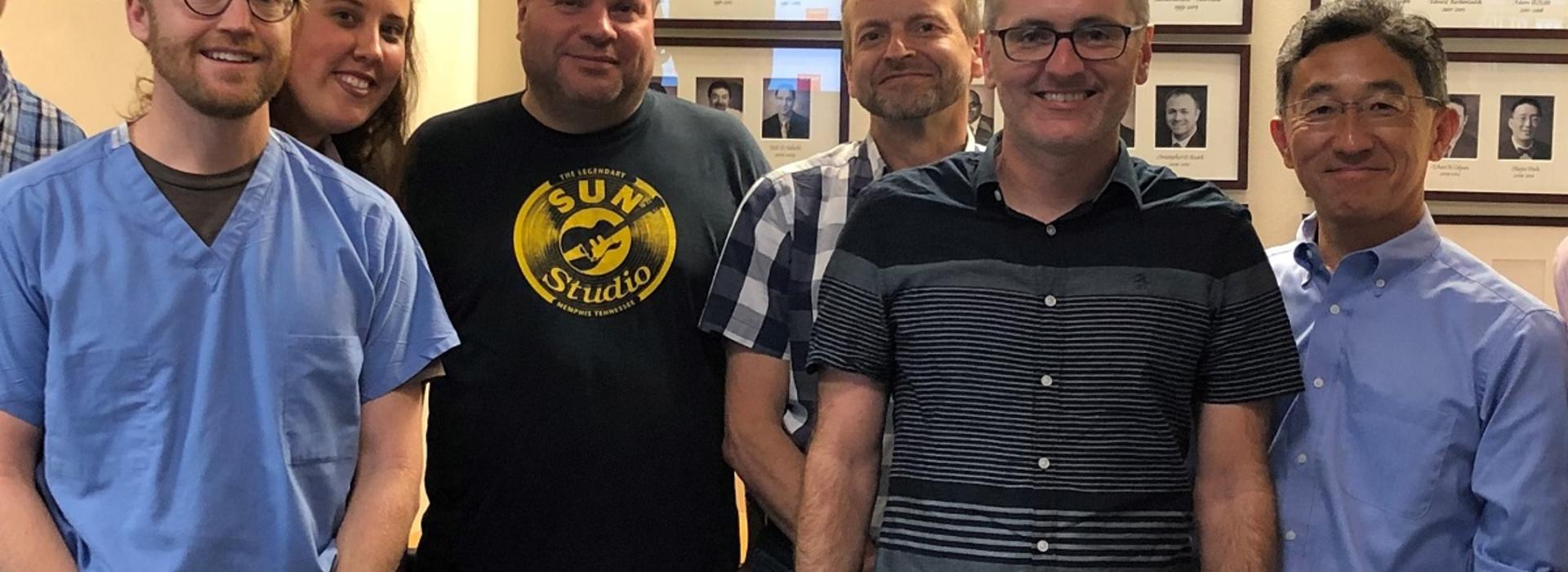
Collaborative work being done on brain aneurysm inspires visit from like-minded institution
Intracranial aneurysms are like ticking time bombs in the brain. When an aneurysm ruptures, mortality varies between 30% to 60% and about 66% of survivors have significant, disabling neurologic deficits. While treatable, current therapies are associated with high complication rates, including stroke or death. The cause of intracranial aneurysms remains unknown and what is known about their expansion and rupture remains controversial.
Emerging evidence suggests that expansion of intracranial aneurysms may be related to:
- Abnormal flow dynamics within the aneurysm leading to alterations in wall shear stress
- Morphologic abnormalities of the aneurysm shape and size leading to focal wall changes
- Cellular level abnormalities leading to focal areas of weakness in the aneurysm wall, including inflammation and matrix remodeling.
A multidisciplinary group of scientists at the University of Minnesota want to improve on what’s known today about brain aneurysms. The group is called the Brain Aneurysm Research Consortium (BARC) and its goals include identifying how aneurysms develop, why they grow, and why they rupture.
BARC was founded in 2018 by Andrew Grande, MD, a cerebrovascular specialist in the U’s Neurosurgery Department, and Bharathi Jagadeesan, MD, who is a neurointerventional radiologist with the Department of Radiology and the Medical Director of the Center for Magnetic Resonance Research (CMMR). Both physicians treat patients with aneurysms. They were joined by:
- Pierre-Francois Van de Moortele, MD, PhD, Associate Professor, Center for Magnetic Resonance Research. “Pierre’s expertise is in high-field MRI [7 and 10-Tesla],” said Grande. “He helps us by using 4-D MRI to evaluate flow in our patients’ aneurysms.”
- Filippo Coletti, PhD, McKnight Land-Grant & Associate Professor, Department of Aerospace Engineering and Mechanics. “His expertise is in flow dynamics – the flow of anything through a pipe, which in our case would be a blood vessel in the brain,” Grande explained. “Aneurysms have unique shapes, which makes flow dynamics unpredictable and interesting to explore.”
- Patrick Alford, PhD, Associate Professor, Department of Biomedical Engineering. “Patrick’s work is with tissue elasticity,” Grande said. “Cells that have abnormal elasticity may lead to aneurysm growth and rupture.”
- Brenda Ogle, PhD, Professor and Department Head, Department of Biomedical Engineering. “She is looking at the wall of the aneurysm and its cellular composition,” noted Grande. “It’s well known that there is inflammation in the aneurysm wall, and that it may be related to both its growth and rupture.”
To further their research when treating their aneurysm patients, Grande, Jagadeesan and their surgical teams image the patients’ aneurysms with 7-Tesla MRI, do 3D models and image them over a 24-hour time period with the 7-Tesla MRI, then clip the aneurysm and take tissue samples for evaluation by BARC.
Consortium members also work with staff in the U’s Neuroanatomy Lab. “We’ve been isolating control blood vessels from cadavers for some time,” said Grande. “In addition, if the U’s Bequest Program has patients with brain aneurysms, they isolate them for us. We’re in the process of building a brain aneurysm bank, which will help us with further studies.”
Visitor from Barrow Neurological Institute
The work being done by BARC caught the attention of Professor of Neuro-anesthesiology and Neurobiology Tomoki Hashimoto, MD, who leads a translational research program at the Barrow Aneurysm and AVM (Arteriovenous Malformation) Research Center (BAARC) at Barrow Neurological Institute in Phoenix, AZ. In 2017, Dr. Michael Lawton, CEO and President of the Barrow, established this research center to tackle unmet needs in advancing the research of brain aneurysms, AVMs, and cerebrovascular diseases and ultimately improving patient care.
"Exciting research platform"
Hashimoto recently accepted an invitation from Grande to visit the U of M campus and get more acquainted with the work being done by BARC. “I have been studying brain aneurysm for more than 10 years, so I share the same research interest with Andy and his colleagues,” he said. “I focus on why aneurysms rupture and want to develop therapies that help prevent that from happening.
“One of the fascinating things is that they are building an exciting research platform that brings people in from different backgrounds,” Hashimoto continued. “Using that approach, they should be able to address extremely challenging questions about brain aneurysm. I really like that.”
Barrow’s brain aneurysm research also takes a multidisciplinary approach and has much in common with the U’s BARC. Hashimoto believes that provides a great opportunity for working together. “Our collaboration will capitalize on the strengths of our organizations,” he said. “Barrow has a high volume of brain aneurysm patients, a long track record of collecting human tissues for aneurysm research, and a productive pre-clinical research group. The University of Minnesota has this very exciting multidisciplinary research platform. When we combine the two together, we can do true translational and clinical research that focuses on preventing the rupture of brain aneurysms.”
Importance of cross-talk
Hashimoto added that there aren’t too many research groups in this country focusing on brain aneurysm. “Unless we work together, we can’t answer the important questions to help people with the condition,” he explained. “Cross-talk among different institutions, cross-talk between different research labs will be extremely important. I’m glad I was able to visit the University of Minnesota to see what they’re doing.”
Raising funds for aneurysm research
In addition to the work Grande does with his aneurysm patients and the Brain Aneurysm Research Consortium, he decided to take an unusual path to raise money for funding aneuysm research. He committed to raising $5,000 while running the Nov. 3, 2019, New York Marathon in less than six hours. Please consider helping him reach his fundraising goal. Thank you!



